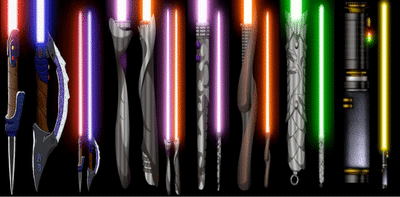The lightsaber (less formally, the laser sword) was more than just the distinctive weapon of the Jedi, it was a segment of the order’s history and its ultimate symbol for millennia. There could be no Jedi without a lightsaber and no lightsaber without a Jedi in the eyes of galactic denizens. Over the years, it came to be associated with gallantry and elegance otherwise lost in an age of blasters. Jedi traditionally constructed their own lightsaber as part of their training. To carry a lightsaber was an example of incredible skill and confidence, dexterity and attuning to the Force. Since its plasma blade was essentially weightless, the weapon produced a gyroscopic effect, and so it was very difficult to handle safely. Yet this made the weapon ideal for force-sensitive users who’s ability to predict the various energy pulsations through the force allowed him or her to compensate for them. They also served as a means by which a Jedi’s focus was attuned to the force during combat. For the same reason, it was also a very quick weapon, and superhuman reaction times were necessary to capitalize fully on this advantage. Only a handful of non-Force-sensitives have been known to master it, and none of them has ever presented a challenge for a fully-trained Jedi, save the lethally effective General Grievous.
History
Millennia in the past, about 9,990 BBY, the Jedi discovered that a super-heated plasmoid substance could be generated and held in place with a field around the plasma. The field could be set so that the plasmoid-like substance could not escape, but other objects could pass into the ultra-hot core. This created a deadly blade of energy that could slice its way through almost any substance. Such fields blocked one another, so the best defense against one blade was another blade. The field could be maintained almost indefinitely if linked to the generating device, because it functioned as a closed loop.
Thus the lightsaber was invented. The first lightsaber-like weapons were developed for siege purposes, using “frozen blaster” technology. The separate power pack they required was often worn on the back.
 |
| Jedi and Dark Jedi battle one another with protosabers. |
The lightsaber eventually evolved to have a smaller energy pack that could be worn on a belt. In time, the power pack was miniaturized enough to fit into the weapon’s hilt.
This smaller lightsaber gave the advantage to hand-to-hand troops whose adversaries (with high-density armor and even personal repulsor shields) were impervious to primitive slugthrowing weapons.
| Odan-Urr wielding a protosaber |
Further advances in the science of field technology allowed for a self-sustaining bubble of containment to be generated. A plasmoid could be generated and flung out at an opponent for quite some distance before it finally dissipated. This gave way to the invention of the blaster. From then on, lightsaber combat evolved to include forms that could counter blaster bolts as well as other blades.
After the Great Jedi Purge, lightsabers became rare relics. However, lightsabers remained prized by some collectors, and some black market sales occurred. They only truly re-entered the galactic scene with the rise of the New Jedi Order.
Since that time various dissenting force-able factions have arisen and the mass production of lightsabers has resurfaced, as it seems to have done in the past, during the Clone Wars, when the need for lightsabers was greatest. Such groups that made use of mass production outside the Jedi Order were the Reborn followers of the fallen Jedi Desann, and the Disciples of Ragnos. The traditions of personal construction or customization of lightsabers has come back into vogue among the New Jedi, as in times past, but also bourne partially out of necessity, due to the initial scarcity of the weapons following the Empire’s purge. With the discovery of previously “lost” Old Republic Jedi documents and resources, the personal craftsmanship of Lightsabers has become less a case of necessity but perhaps more one of the personal self-discipline so characteristic of Jedi ideals.
Lightsaber colors
 |
| Exar Kun with his saberstaff during the Sith War. |
The color of a lightsaber blade was heavily dependent on the crystal used in its construction. For the Jedi, these crystals came in many colors and were extracted from natural deposits. Sith, however, made use of synth-crystals to power their weapons, which resulted in Sith blades being almost uniformly red. It should be noted that synthetic crystals do not always result in red blades, since Luke Skywalker’s synthetic crystals resulted in a green blade. Jedi have been known to produce blades that are red or approaching that color (such as purple), but perhaps due to the force of tradition, the Jedi Order typically avoided any colors that might associate them with the Sith.
Ancient Jedi wielded blades of many colors; blue, green and red, as well as purple, orange, silver, turquoise, pink, bronze, yellow, viridian, and possibly white and gold, among others; the full variety and extent of focusing gems, and consequently, of colors, is unknown.
 |
| Mace Windu’s blade |
By the time of Battle of Naboo, however, the Jedi used the caves of Ilum as their primary source of lightsaber crystals. These caves were rich in green and blue crystals, explaining the absence – with the exception of Mace Windu’s blade – of alternate colors among the Jedi ranks during this period. During the Clone Wars, major portions of the Ilum caves were destroyed by the Confederacy of Independent Systems. The Empire destroyed crystals on an even larger scale after the war. Bereft of these resources, the Jedi of Luke Skywalker’s Order were again forced to scour the galaxy for usable crystals, creating a resurgence in more varied blades. One lightsaber in particular, created by the Jedi student Gantoris, was violet with patterns of rainbow light rippling across its white core.
|
The crystal cave on Ilum.
|
 |
| Red Sith blade |
The ‘synthetic’ red blade producing crystals favored by the Sith can create a somewhat more powerful blade than blue or green crystals, but are not as pure due to their artificial nature and can thus be undesirable as the focus of a lightsaber. Often the Sith Master would craft the crystal and gift it to his apprentice. Despite the differences in color, the function of the different colored blades is the same. Once techniques of synthesizing crystals became more well known, the restrictions on color because less of a concern, except for matters of personal taste or political statement. Various “Dark Jedi” not associated with the extinct Sith Order often retain the colors used as Jedi, though some continue to choice red for symbolic reasons. Plenty of examples exist, however, of Dark Side users who did not use red blades, and even those who were not Dark Siders who used red blades with no ill effects. This has lead many to assume that the color is merely a symbolic consideration, depending on the user.
 |
| Star Killer with Red blade |
Some have speculated that the red lightsabers are actually a product of the influence of the Dark Side of the Force. It is alleged that somehow the one constructing the saber actually “infuses” some aspect of the Dark Side into the device itself, causing the blade to change color. This might also explain why Dark Side users so often switch to red after turning. However such a notion could be explained away as superstition, and speculation based on the common practice of the Sith using red blades. Those who embrace the Dark Side may simply wish to imitate the Sith traditions by choosing a color favored by them. That such misinformation could be spread among the general public would give the Jedi one more reason not to associate with them by choosing colors other than red.
There is some controversy surrounding what exactly produces blade color in a lightsaber. Is it purely based on the type or color of crystal, the focusing mechanism, power level, “tuning” or some other aspect? Clearly, the crystal has some effect, but it may not be the sole factor in determining the color. It can be difficult to say since so much lore has become tied up in the lightsaber over the centuries and so much information distorted or lost due to the influence of the Empire and the Sith.
Lightsaber types
Standard lightsaber
The standard lightsaber consisted of a straight hilt approximately 20 to 30 centimeters long. As it is the standard make, it has no defining features other than details on individual hilts, as each weapon is often self-fabricated by the wielder and customized to suit their specifications.
Electrum lightsaber
The only difference electrum lightsabers had compared to the standard was that their casing was built of the golden electrum metal. A purely cosmetic accessory, this feature was only allowed to high-ranking members of the Jedi Order, being a prestigious honor bestowed on masters who have demonstrated their strength and skill.
| A Selkath Jedi with a retrosabe |
Protosaber
Before the advancement in lightsaber technology after the Hundred-Year Darkness, lightsabers had significantly higher power requirements, necessitating belt-mounted power packs; these packs were connected to the hilt by a cord. While a massive advancement over the highly unstable original lightsabers, protosabers were eventually rendered obsolete by miniaturized power cells and the inclusion of the superconductor technology that allowed the energy of the blade to return to the hilt, creating an energy loop that only lost power when interrupted, such as when a lightsaber cut.
Enthusiasts would later mimic this design using modern parts, citing aesthetics and improved cutting power as benefits of these “retrosabers”.
Double-bladed lightsaber
Also referred to as saberstaffs and Sith lightsabers, double-bladed lightsabers consisted of a single hilt that projected a blade from both ends, resulting in a deadly staff-like weapon. Most saberstaff hilts were of increased length, as they usually consisted of two separate lightsabers connected at the pommels.
According to the Tedryn holocron, saberstaffs were first invented by the Sith Lords of the old Sith Empire. The first recorded usage of the weapon was by the Sith Lord Exar Kun, who obtained the schematics for the weapon from a Sith holocron, using them to modify his existing Jedi lightsaber.
 |
| A collection of Sith saberstaffs during the Cold War. |
The usage of double-bladed lightsabers eventually gave rise to the use of paired lightsabers. As many double-bladed lightsabers were simply two separate lightsabers joined at the pommel, this was taken advantage of and the weapons were connected with a locking mechanism rather than a solid weld, allowing the two weapons to be separated for Jar’Kai dual-blade combat. Many duelists used the paired function to surprise enemies in combat, wielding it as a saberstaff before separating the weapons. Other versions of the paired lightsaber had the weapons joined by a fiber cord instead of a locking mechanism. Those linked by the fiber cords were held by the cord and flailed about, exchanging control for unpredictability.
Guard shoto
A variation on the standard short shoto lightsabers, guard shotos featured an elongated hilt with a secondary handle built angling 90 degrees out from the main hilt. They were built to be carried by the second handle, with the blade parallel to the forearm, allowing the weapon to be easily used for blocks. Due to the defensive nature of the weapon, it is recommended that the casing be machined out of lightsaber-resistant phrik alloy.
Crossguard lightsaber
An extremely rare variant only seen in the hands of skilled duelists, crossguard lightsabers, also known as forked lightsabers, feature a specialized hilt that emits two blades. One blade is the standard lightsaber blade, but the second is a significantly shorter and thinner blade projected by a secondary emitter next to the main at an angle. The secondary blade is used as a guard to protect the hand, and on occasion to catch attacks between it and the main blade.
 |
| Asajj Ventress’s curved Lightsabers |
Curved-hilt lightsaber
Curved-hilt lightsabers are a type of hilt that features hilt with a built in curve. This is usually done to allow the hilt to fit better into the palm, facilitating the use of one-handed fighting styles such as Makashi, or to provide variable blade angle to confuse opponents.
Long-handle lightsaber
Built to cater to specific fighting styles, long-handle lightsabers featured a lengthened handle that provided the duelist with more surface area to place his hands, and providing more leverage for attacks.[24] The length of long-handled lightsabers varies considerably, with some examples, such as the weapon of Warb Null simply being double the length of standard hilts, and others, such as Darth Nihl’s weapon, being staffs with a lightsaber blade on the end.
Lightsaber pike
Resembling pole-arms in many respects, lightsaber pikes feature extremely long handles, up to two meters long, with a somewhat shorter and thicker lightsaber blade. The handle is machined from phrik alloy to prevent it from being cut in two, as the purpose of the weapon is to provide vastly increased its own range.
 |
| Kazdan Paratus’ lightsaber pike. |
Sabercane
The sabercane was a simple variation on the standard; a lightsaber concealed as the head of a cane. In combat, the handle would be detached from the body of the cane and wielded normally. Tera Sinube wielded such a weapon, as did the Sith acolyte Haazen.
Cutting power
Lightsaber blades do not radiate heat unless they come into contact with something. Then the intensely hot blade can cut through almost any substance when appropriate force is applied. A few notable exceptions do exist however:
- Cortosis ore: A unique substance able to shut down a lightsaber upon contact. Some types of Cortosis armour merely resist a blade rather than shorting it out.
- “Armorweave” is a cloth that is said to give some resistance to lightsabers, though such protection afforded is obviously limited by the thickness and reinforcement of the material (just as a “bullet proof vest” is not impenetrable to all bullets).
- Phrik alloy: Used in electrostaffs, Palpatine’s lightsaber and Dark Trooper armour.
- An unnamed metal superconductor used for ship armor hundreds of years before the Galactic Empire.
- Mandalorian iron: A metal used by the Mandalorian warriors.
- Yuuzhan Vong bio-engineered weaponry and armor, such as the amphistaff.
- Certain types of energy shields.
- Other dense or resistant materials, like the armour worn by Lord Darth Vader and the hulls of starfighters during the Clone Wars.
Methods of use
The lightsaber was a very versatile weapon, owing to its unique lightness and omni- directional cutting ability. It could be wielded one-handed with ease, though Jedi were routinely trained in using the saber with both and either hands, so as to be prepared for all situations. In later periods, only rarely would Jedi face an adversary with a weapon capable of deflecting a lightsaber. Using Jedi prescience, a lightsaber wielder could anticipate a blaster bolt’s path and deflect it with his or her lightsaber.
Several styles or “forms” of lightsaber combat were developed over the years; some involved dual-wielded lightsabers, and sometimes even double-bladed lightsabers.
- Form I: Shii-Cho
- Form II: Makashi
- Form III: Soresu
- Form IV: Ataru
- Form V: Shien / Djem So
- Form VI: Niman
- Form VII: Juyo/Vaapad
- Form VIII: Sokan
- Form IX: Shien
- Form X: Niman / Jar’Kai
Construction details
The lightsaber was made up of a short polished metallic cylindrical tube (30 centimeters) that emitted a beam of a plasma-like substance, or plasmoid.
All lightsabers contain some common basic components:
- A handgrip
- An activation stud plate
- A safety switch
- An emitter matrix
- A lens assembly (focusing crystal)
- A power cell
- A power conduit
- A recharge socket
The focusing crystal was the central component of the lightsaber. The crystals were wired to the diatium power cell, which acted like an energy source for the lightsaber.











